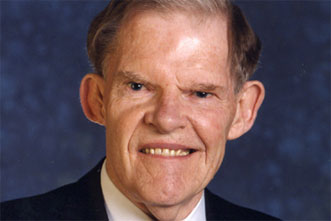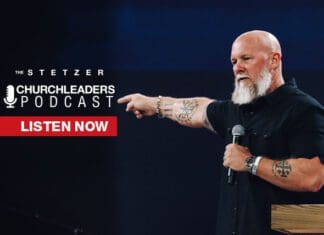The assigned passage was 1 Samuel 17, the story of David and Goliath. I felt good about my three-point outline. It was perfectly alliterated with words like “courage,” “conquering,” and some other “C” word I felt certain would impress. I was so confident I volunteered to go first—to expose my sermonic offering to Haddon Robinson’s scrutiny in front of our Doctor of Ministry class. The Scriptures proved true. Pride really does come before a fall.
“That looks like something you pulled out of Simple Sermons for Sunday Evenings,” Haddon chided. Astutely, I sensed that the good doctor did not consider this book to be a classic in the field. He continued, “Nobody talks like that anymore—except in the pulpit!” Duane Litfin, Haddon’s co-teacher for the week, chimed in, “What Haddon’s saying is that he’s afraid you might actually go out and try to preach that thing!”
That was more than ten years ago. I never alliterated a sermon again. It was the first lesson I learned about preaching—and about life and ministry—from Dr. Haddon Robinson, the Harold John Ockenga Distinguished Professor of Preaching at Gordon-Conwell Theological Seminary. It wasn’t the last. During the past decade I’ve been privileged to sit under Haddon’s teaching—first in his Doctor of Ministry program and later during annual preaching seminars (for alumni of the program). His instruction and his life have greatly impacted me. God has used him to help me grow as a preacher, a pastor, and a follower of Jesus. Here are a few of the lessons he’s taught me:
Don’t make preaching more complicated than it is.
As a preacher, there are only three ways I can approach a biblical text: 1) I can explain it by answering the question, “What does it mean?”; 2) I can prove it by answering the question, “Is it true?”; 3) I can apply it by answering the question, “What difference does it make?”
In some sermons I might answer only one of these “developmental questions.” In other sermons I might address all three. For instance, when I read a passage like Matthew 21:21-22 (“I tell you the truth, if you do not doubt, not only can you do what was done to the fig tree, but also you can say to this mountain, ‘Go throw yourself into the sea,’ and it will be done…”), my heart cries out for answers to all three questions. I might address them all in one sermon or, I might preach a three-week series on “Praying with Faith.”
Every sermon should have one central “big idea.”
In Haddon’s words, “A sermon should be a bullet, not buckshot.” He writes, “Ideally, each sermon is the explanation, interpretation, or application of a single dominant idea supported by other ideas, all drawn from one passage or several passages of Scripture.” He continues, “Three or four ideas not related to a more inclusive idea do not make a message; they make three or four sermonettes all preached at one time.”
It’s impossible to preach an effective sermon if we don’t specifically know what we’re preaching about. As another preaching professor was fond of reminding me, “Fog in the pulpit, fog in the pew.” In Biblical Preaching, Haddon quotes J.H. Jowett, “I have the conviction that no sermon is ready for preaching…until we can express its theme in a short pregnant sentence as clear as a crystal.” Each week I need to do the hard work of determining the central truth of my sermon text. Until I do, my sermon will not be relevant, nor can it be practically applied to the lives of my hearers.
Expository preaching—properly understood and practiced—is our calling.
Before I go further, please don’t miss the phrase, “expository preaching—properly understood and practiced.” Much of what goes by the name “expository preaching” amounts to little more than a running commentary on the ancient biblical text (“Last Sunday we got through chapter 7, verse 12. Today we begin with verse 13…”). Information without relevance. Knowledge without application. No central idea. If this is expository preaching at all, it is bastardized expository preaching! As taught and modeled by Haddon Robinson, expository preaching is as crisp and relevant as the Bible itself. An expository sermon can take many forms—inductive, deductive, narrative, and yes, even topical. So what makes an expository sermon expository? An expository preacher never brings his sermon idea to the text. He draws his sermon idea from the text. In other words, an expository preacher never imposes a topic on the text. He lets the text speak for itself and shapes his sermon accordingly.
During my second-year D/Min seminar, I attended services at a well-known, rapidly growing church. The next morning at breakfast, Haddon mentioned how some preachers will essentially outline their sermons and then go fishing for Bible verses that support their outlines. He mentioned how some went so far as to search various translations until they found the wording that best supported each of their individual outline points. I pulled out the sermon outline from the previous day. Sure enough, the Bible verses quoted on the outline came from at least four different modern translations and paraphrases. Each was specifically selected to “fit” the preacher’s outline.
Whenever the biblical text becomes a servant to our ideas (or to our outlines) we miss our calling as preachers. In his book, Biblical Preaching, Haddon writes, “Whether or not we can be called expositors starts with our purpose and with our honest answer to the question: ‘Do you, as a preacher, endeavor to bend your thought to the Scriptures, or do you use the Scriptures to support your thought?’”
If you have doubts about the power and relevance of real expository preaching, I encourage you to purchase (or download) several of Haddon Robinson’s sermons. Listen to them. I promise you won’t be bored! And neither will the members of your congregation when you answer God’s call to properly practice expository preaching.
Without a definite purpose, no sermon is worth preaching.
Before I preach any sermon, I should be able to answer the question, “Why am I preaching it?” In other words, what do I want to see happen in the lives of my hearers? Haddon writes, “We do an assortment of things when we face our congregation. We explain, illustrate, exhort, exegete, and gesture, to list a few. But we are to be pitied if we fail to understand that this particular sermon should change lives in some specific way.”
How, then, should we go about determining the purpose of this week’s sermon? Haddon’s answer is that we should seek the purpose behind the passage we are preaching. “As part of your exegesis, you should ask, ‘Why did the author write this? What effect did he expect it to have on his readers?’”
When fleshing out the purpose of a sermon Haddon suggests the following in Biblical Preaching, “State in a rough way what you are asking the congregation to do as a result of what you have preached. Be as specific as possible. If someone came to you next week and said, ‘I have been thinking about what you preached last Sunday, but I don’t know how what you said applies to my life,’ would you have an answer? Picture the truth you have preached being acted on in some specific situations.”
Work hard on your sermon’s introduction, transitions, and conclusion.
Effective introductions capture attention, surface a need that the sermon will address, and introduce the body of the sermon. Good transitions review the major points of a sermon and show how the major and minor points of the sermon relate to each other. They introduce each new section or “move” in a sermon. Haddon writes, “…they enable your congregation to think your thoughts with you. Concerning conclusions he adds, “The purpose of your conclusion is to conclude—not merely stop.…Your congregation should see your idea entire and complete, and they should know and feel what God’s truth demands of them.” Each of these elements of a sermon is critical and requires special attention.














